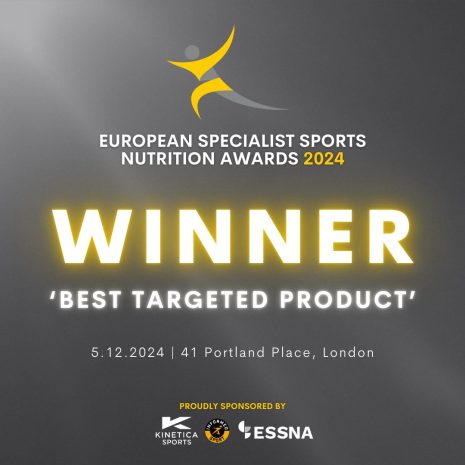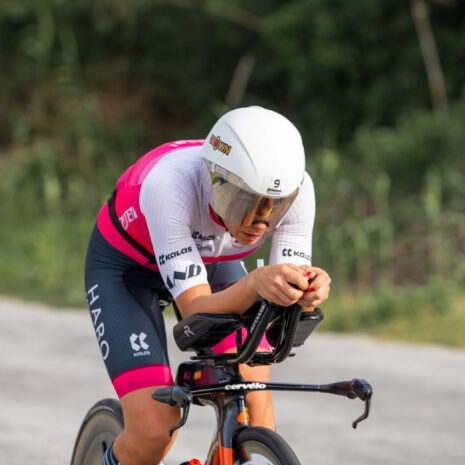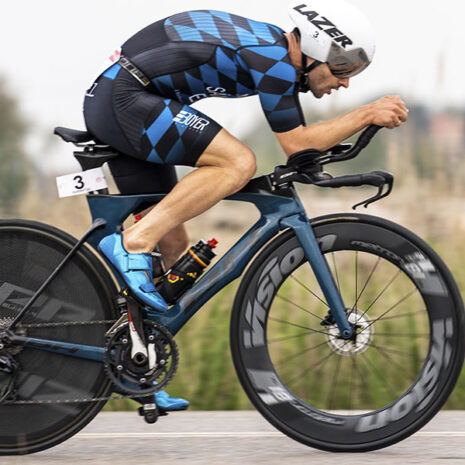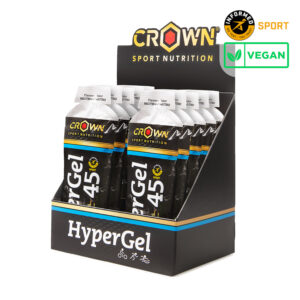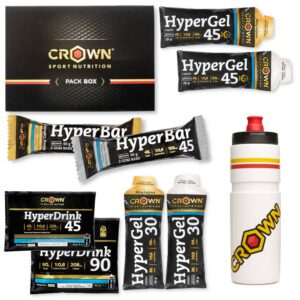HyperDrink 45 (1:0,8), Bebida isotónica alta en hidratos de carbono
Rango de precios: desde 2,20€ hasta 24,95€ Iva incluido
Bebida isotónica con 45 g de carbohidratos en 500 ml de agua(9%) y 235 mg de sodio. Relación 1:0,8 Maltodextrina:Fructosa. Excelente disolución, sabor y textura.
Contiene sólo 3 ingredientes. Envío gratuito.
- Envío gratis a partir de 25€.
- Entrega en 24/48h.
- ¿Tienes dudas? Escríbenos por WhatsApp o a clientes@crownsportnutrition.com

Bebida ISOTÓNICA Alta en Carbohidratos con un plus de Sodio
HyperDrink 45 es una bebida deportiva Bebida isotónica alta en hidratos de carbono. De la más alta calidad y con una composición ideal de hidratos de carbono y sodio, nutrientes necesarios para mejorar el rendimiento tanto de los entrenamientos como de las competiciones de larga duración y/o alta intensidad. En una única toma de 500 ml tendrás 45 g de carbohidratos más un aporte extra de Sodio (aprox. 235 mg).
- Aporta 45 g de Carbohidratos en 500 ml de agua
- Mezcla de Maltodextrina y Fructosa en ratio 1:0,8
- Con un plus de Sodio (Sal marina) 235 mg
- Disolución instantánea y traslúcida, sin decantación
- Máxima absorción y digestibilidad
- Apto para Veganos y libre de alérgenos
HyperDrink 45 contiene la mezcla idónea, según la ciencia, de hidratos de carbono, Maltodextrina y Fructosa, en ratio 1,25:1 (comúnmente 1:0,8). Se ha demostrado que en ejercicios prolongados el uso de carbohidratos que se absorben en el intestino por diferentes transportadores (conocidos como SLGT-1 y GLUT) es la única forma de aumentar la tasa de asimilación y oxidación de hidratos de carbono exógenos por encima de los 60 g/hora (Currell, K. et al., MSSE. 2.008; Earnest, C.P. et al., JSCR. 2.004). Para ello las investigaciones dicen que lo ideal es combinar una fuente que aporte glucosa (en nuestro caso maltodextrina) con fructosa.
¿Por qué combinarlos en ratio 1,25:1 (1:0,8) y no en el clásico 2:1 u otro?
Porque las últimas investigaciones han demostrado que con este ratio conseguimos la máxima oxidación de hidratos de carbono exógenos, es decir, que nuestro cuerpo obtenga la máxima eficiencia energética de los carbohidratos consumidos. Esto es algo muy importante cuando la ingesta de carbohidratos en un volumen de líquido pequeño es muy elevada (40 g / 500 ml) para asegurar que la gran mayoría (74% de eficiencia) de lo ingerido va a ser utilizado en la producción de energía sin comprometer un posible malestar estomacal/intestinal (Rowlands, D.S. et al., SM. 2.015).
¿Por qué utilizar Maltodextrina como fuente de glucosa y no otra?
Porque, según la bibliografía científica existente a día de hoy, parece ser la mejor fuente cuando lo que se busca es una alta eficiencia en el uso de glucosa exógena, sobre todo cuando queremos que los aportes de carbohidratos sean elevados en volúmenes pequeños. Usándola conseguimos la máxima oxidación de hidratos de carbono exógenos frente a otras fuentes de glucosa como la ciclodextrina (Cluster Dextrin®) o la isomaltulosa (Palatinose®). La ciclodextrina o dextrina cíclica altamente ramificada (Cluster Dextrin®, como patente más reconocida) parece interesante a nivel osmótico para evitar el posible malestar intestinal, pero a nivel de eficiencia energética, a día de hoy no hay evidencia científica que demuestre que es mejor. La isomaltulosa (Palatinose®, como patente más reconocida), por una parte, es una fuente de glucosa y fructosa, por lo que no es puramente una fuente de glucosa, pero al margen de eso, por otra parte los estudios han demostrado que su eficiencia energética es menor frente a otros carbohidratos (41% menor vs sacarosa, por ejemplo) (Achten, J. et al., JN. 2.007), es decir, que parte de lo que se consume no se utiliza como fuente de energía (siempre dentro del contexto de toma durante la práctica deportiva), por lo que no parece muy lógico tomar un carbohidrato que parte de él no se va a utilizar para aportarnos energía, que es justo lo que buscamos al consumir este tipo de productos.
Maltodextrina frente al uso de la glucosa
A parte de por su alta eficiencia energética, comentada anteriormente, el emplear maltodextrina frente al uso de la glucosa como propia fuente de glucosa, también tiene que ver con que el uso de este ingrediente es más favorable a nivel osmótico por ser una molécula de mayor tamaño, lo que disminuye la osmolalidad de la mezcla y esto minimiza el posible malestar gastrointestinal que puede producirse con el consumo elevado de carbohidratos durante el esfuerzo físico (Rowlands, D.S. et al., SM. 2.022). La conclusión es que a nivel de eficiencia energética tanto la glucosa como la maltodextrina son similares, por lo que podríamos usar cualquiera de las 2, pero a nivel osmótico (evitar problemas gastrointestinales) es más favorable el uso de la maltodextrina. Además, por matices organolépticos, la maltodextrina apenas aporta sabor, mientras que la glucosa es más dulce, algo que en este caso no deseábamos.
A modo de resumen y como conclusión sobre los hidratos de carbono empleados, en el marco de los productos con una alta concentración de carbohidratos para tomar durante el esfuerzo, lo más importante es que la eficiencia energética de los hidratos de carbono exógenos consumidos sea máxima y minimizar al máximo los problemas gastrointestinales y, según la ciencia, a día de hoy, esto solo se consigue combinando estas 2 fuentes de carbohidratos (Maltodextrina/Fructosa) y en las proporciones comentadas de 1,25:1 (más comúnmente conocida como 1:0,8) (Rowlands, D.S. et al., SM. 2.022). Para completar la fórmula le hemos añadido como aporte del mineral Sodio (Na), el cloruro sódico en forma de Sal marina. El sodio es el electrolito más importante durante la práctica deportiva, porque es el que más perdemos con el sudor y es fundamental para mantener la hidratación durante la actividad física (Panel NDA. EFSA Journal. 2.011). Además, la hemos añadido en esa cantidad y no otra, porque está dentro del rango establecido para generar una mayor absorción de agua y carbohidratos en el lumen intestinal (Shi, X. et al., IJSNEM. 2.010; O´Brien, W.J. & Rowlands, D.S., AJPGLP. 2.011).
¡Perfecta disolución!
El hándicap que tienen algunas bebidas de este tipo que hay en el mercado, es la solubilidad, siendo complicada o produciendo bebidas poco estables con el paso de las horas. Hemos sido muy meticulosos con esto, por lo que después de elegir las mejores materias primas, hacer varias pruebas y test, hemos conseguido hacer un producto de perfecta disolución, en apenas un minuto se forma una bebida traslúcida y totalmente estable con el paso de las horas (y días). ¡Una vez disuelta pensarás que es agua!
¡Sin sabor!
Buscando la máxima efectividad tanto a nivel energético como a nivel gastrointestinal, hemos desarrollado un producto de alta pureza, por lo que no tiene sabor, solo a nivel organoléptico tiene un ligero toque dulce aportado por la propia fructosa, nada más. No contiene aromatizantes, ni conservantes, ni edulcorantes, ni colorantes, ni ningún otro aditivo.
Modo de empleo: Primero llenar un bidón con 500 ml de agua. A continuación, verter el contenido del sobre y agitar bien hasta que se disuelva. Utilizar un bidón con capacidad de 600 ml o más, por la subida de volumen que se produce al añadir el producto. Con este modo de empleo conseguimos una disolución de: Osmolaridad: 278 mOsmol/litro de disolución; Osmolalidad: 295 mOsmol/kilogramo de disolvente y un pH de 4,94.
Consejo profesional:
Si el ambiente es muy caluroso y/o húmedo: Para mantener una correcta hidratación además es necesario un aporte extra de sales, por lo que se recomienda ingerir aprox. 1 cápsula de PRO Salt Caps cada 60 minutos (1 h) de actividad física.
| INFORMACIÓN NUTRICIONAL | por 100 g | por toma (47 g) |
|---|---|---|
| Energía | 1.636kJ | 769kJ |
| 385Kcal | 181Kcal | |
| Grasas | 0,0g | 0,0g |
| de las cuales, saturadas | 0,0g | 0,0g |
| Hidratos de Carbono | 96g | 45g |
| de los cuales, azúcares | 48g | 22g |
| Proteínas | 0,0g | 0,0g |
| Sal | 1,3g | 0,60g |
| de la cual, Sodio | 500mg | 235mg |
Maltodextrina (DE 16 – 23), fructosa y sal marina (cloruro sódico).
También te recomendamos…
-
HyperGel 30 (1:0,8) Hydro
Rango de precios: desde 2,49€ hasta 24,90€ Iva incluido -
PACK Hyper (1:0,8) Energy Tester 2.0
El precio original era: 32,47€.25,00€El precio actual es: 25,00€. Iva incluido


